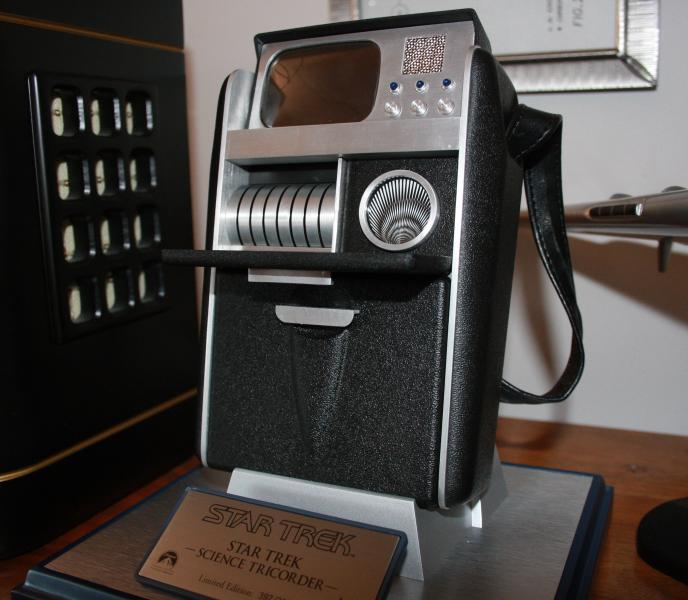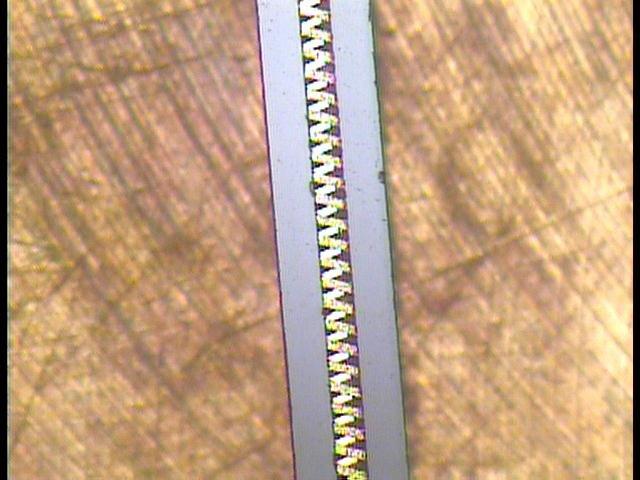Fulfilling a sci-fi dream
For those familiar with the original Star Trek series, the distinctive buzz of the tricorder is unmistakable. Spock or McCoy could point it at any object, and instantly know its chemical makeup, see hidden objects, or diagnose diseases.
 A replica tricorder sits in the office of Teraphysics founder and president Jerry Mearini. As a fan of all things retro, and as a physicist and entrepreneur, Mearini was inspired by the tricorder's pretend powers. A replica tricorder sits in the office of Teraphysics founder and president Jerry Mearini. As a fan of all things retro, and as a physicist and entrepreneur, Mearini was inspired by the tricorder's pretend powers.
He says when his company started working on Terahertz devices, "the first thing that came to my mind is, we’re building the world’s first Star Trek Tricorder.”
He says it may not be science fiction much longer, and while Teraphysics is not building the tricorder itself, they’re "building the engine that drives it.”
The engine is a credit-card sized, high-power Terahertz generator -- technology that’s eluded scientists since the 1960’s.
The Terahertz gap
Light is a spectrum. On one end you have high-energy, high-frequency X-rays; on the other end, low frequency radio waves – like the ones your car antenna’s capturing right now. In the middle of the spectrum is visible light that you see all around you.
People have made use of practically every part of that spectrum in one way or another, except the Terahertz frequencies.
T-rays, as they’re called, fall between the heavily utilized wavelengths of infrared radiation -- think ... your TV remote, or night vision goggles; and microwaves, think… ovens, or advanced radar.
But the equally promising Terahertz range has up until now been relatively inaccessible through existing technologies.
That lack of access has been called the Terahertz gap, but not by Frank De Lucia, a pioneer in the field of Terahertz research at Ohio State University.
He says the Terahertz gap was filled 50 years ago when he and colleagues used Terahertz detectors to see into interstellar space, "but," he says, "it is the spectral region that’s had the least attention.”
De Lucia says the elusive spectral region is virgin territory, “simply because it’s not been worked on much as a function of time. And part of the reason for that is that it’s been difficult and expensive to build sources.”
And De Lucia says the practical, portable Terahertz source that Jerry Mearini is about to show me is a significant jump forward.
A powerful, portable Terahertz source
Mearini brings a small section of an intricately inscribed slab of metal into focus under a microscope.
He points to, "a perfectly fabricated gold helix sitting on a very thin diamond sheet.”
 The oscillator is half as wide as a human hair. Mearini says the tiny gold and diamond Terahertz generator is based on decades-old technology married to today’s nano-fabrication techniques. The oscillator is half as wide as a human hair. Mearini says the tiny gold and diamond Terahertz generator is based on decades-old technology married to today’s nano-fabrication techniques.
He says it’s a vacuum tube, "but a very modern day vacuum tube." Mearini says the underlying concept is, "not unlike the glass vacuum tubes that are in my guitar amp at home, just a much cooler one.”
It took Mearini and his team 10 years of long nights to get it to work, an event they quietly celebrated by cracking open a bottle of 25 year-old Macallan Scotch.
Teraphysics announced the breakthrough last month.
Elliott Brown, an expert in Terahertz technology at Wright State University in Dayton, describes the new device as, "a paradigm shift.”
Brown says, "it would enable a whole class of new experiments that have not been conducted to date, or have not been conducted well to date, because of the lack of power in that frequency region.”
Brown sees enormous potential for the Teraphysics’ device especially in biomedical imaging. In his lab, he uses T-rays to detect skin cancer, to diagnose burns, and to analyze DNA.
Science fiction becomes science reality
At Teraphysics in Cleveland, Mearini sees the potential of his device to identify chemicals, even at a distance.
"The most interesting aspect of Terahertz," according to Mearini, "is that, in that frequency range, you can unambiguously identify molecular species, because most molecular species in that frequency range exhibit what we refer to as resonant signatures.”
 The Terahertz spectrum can also ‘see’ through clothing and paper packaging. The technology is being tested with U.K. partner Teraview in next generation airport scanners to detect hidden objects, or even the chemical signature of bomb material. The Terahertz spectrum can also ‘see’ through clothing and paper packaging. The technology is being tested with U.K. partner Teraview in next generation airport scanners to detect hidden objects, or even the chemical signature of bomb material.
T-rays are being used to link computer systems through high bandwidth wireless, also in secure communications, and data transfer.
Other uses include inspection of paint and coatings, even uncovering art forgeries.
Mearini says this unique area within the electro-magnetic spectrum, "shows so much promise for so many applications that have not really been tapped until now.”
The list of potential uses for Terahertz devices sounds like science fiction, but one Cleveland company, and researchers across Ohio, may soon make them a reality. |